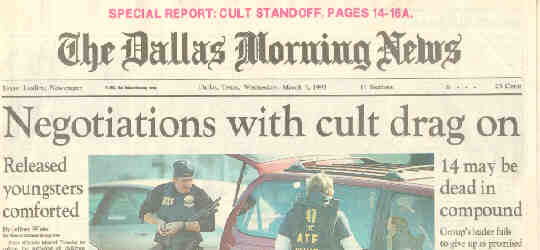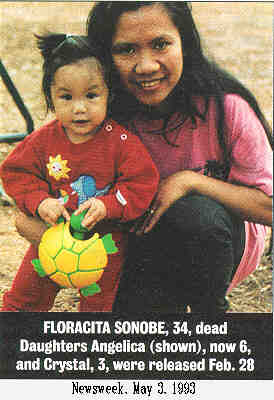
"14 may be dead in compound," ran a headline in The Dallas Morning News, March 3, 1993. A heavy casualty count among the Davidians is believable, given the strafing, the frontal infantry assault, and the flimsy structure. With time, however, the February 28 death count was revised downward. |
The modest plywood shelter the Branch Davidians had built with their own hands could not be expected to withstand the barrage of helicopter machine gun fire and the hail of bullets from the frontal infantry assault of February 28.
Early accounts indicated that a child, or "children" had been killed that day. This was surely not unexpected because the helicopters had fired into the second-story quarters where the children lived. With the unfolding saga in the daily papers came suggestions of high fatalities among the Davidians and conditions likely to cause even more.
- When the Davidians were attacked on February 28, they called
911 and the call was recorded. The Feb. 28
recording captured David Koresh's voice:
"You see you brought your bunch of guys out here and you killed some of my children. We told you we wanted to talk …"
- David Koresh said a 2-year-old girl was killed in the firefight. ( The Dallas Morning News, March 1, 1993, pg. 13A, "Howell's revelation: Wounded sect leader, in rambling interview, says that he is Christ")
- Branch Davidian Steve Schneider stated:
"People are lying dead in here, babies and everything."
(The Dallas Morning News, March 1, 1993, pg. 13A —quote is printed in text-box and is not included in the DMN archive). - A McLennan County official who was familiar with negotiations said as many as 14 people are believed dead and "a whole lot" are wounded. (The Dallas Morning News March 3, 1993, pg. 14A, "Negotiations with cult drag on: 14 may be dead in compound; Group's leader fails to give up as promised")
- In the first few days, some of the Davidian children were sent
from Mt. Carmel into the custody of the attacking forces.
"The children all spoke of seeing bullets flying through their windows in their quarters and seeing numerous wounded people in the compound," said Joyce Sparks of the state Children's Protective Services office. (The Dallas Morning News, March 10, 1993, pg. 25A, "State retains custody of most cult kids")
-
Speaking through Attorney Peterson, Branch Davidian Kathy Schroeder stated:
"She acknowledged that other sect members were wounded and need medical attention." (The Dallas Moring News, March 15, 1993, pg. 9A, "Agents use light against sect as psychological maneuver; Attorney for jailed member says group's hardships growing")
- Agents offered medical treatment to wounded cult members if they ventured to the edge of the compound. Those not requiring hospitalization would be allowed to return to the compound, said Agent Ricks. (The Dallas Morning News, March 18, 1993, pg. 16A, "Up to 30 in cult want to leave, FBI agent says; They seek agency's assurances")
- FBI agent Dick Swensen stated, "Also, the wounded people and the conditions inside the compound add to the pressures on this to end this thing soon." (The Dallas Morning News March 22, 1993, pg. 6A, "Release of 7 buoys hopes for end to cult standoff")
Early in March, Waco researcher Ken Fawcett captured raw TV footage, not shown on nightly newscasts, which showed several black-clad men carrying what appeared to be a small body in a body bag to an ambulance waiting outside the Mt. Carmel Center. The identical footage is shown in "Waco, the Big Lie."
Reports also indicated that 14 Branch Davidians in the Mt. Carmel Center at the time of the raid had been killed. Another Davidian, Michael Schroeder, was off-site when the raid occurred, and was killed when he was repeatedly shot while attempting to get back to the Center to reach his family. Schroeder's death would have been the fifteenth Davidian death on February 28.

"Floracita Sonobe, 34, dead. Daughters Angelica (shown), now 6, and Crystal, 3, were released Feb. 28." (Newsweek, May 3, 1993). Floracita is identified as Mt. Carmel Doe #4.
On March 2, arrangements had reportedly been made to end the confrontation. David Koresh was to tape a message he wanted the American people to hear. The taped message would be aired on national radio. The dead and the wounded would be taken to Hillcrest Baptist Medical Center and the Branch Davidians would confront the government in the courtroom (The Dallas Morning News, March 3, 1993, pg. 14A, "Negotiations with cult drag on: 14 may be dead in compound; Group's leader fails to give up as promised").
Hillcrest Hospital had set up a temporary morgue and emergency room to handle the Davidian dead and wounded. According to The Dallas Morning News, "Hillcrest expected that the Davidians were going to arrive after 2:30 pm on March 2. A triage area was set up outside the emergency room, and an area for a temporary morgue designated." Shortly before 1:00 pm, "agents arrived at the hospital in a large white truck and took up positions on rooftops surrounding the emergency room. They surveyed the area through binoculars and clutched assault rifles to their chests." (ibid.)
But the dead and wounded Davidians never arrived at Hillcrest. David Koresh's taped massage was not aired on national radio but on a local station. The FBI would later say that David Koresh simply broke his word on March 2 and refused to let anyone leave. They implied that the local radio airing of Koresh's taped message should have been good enough.
On the other hand, there could be an alternate explanation for the events of March 2. The FBI's Hostage Rescue Team had fully installed itself as the tactical unit in charge of the siege on that date (Treasury Report, pg. 118). Perhaps the "new management" decided against the release of the dead and the wounded. Surely there would be a good reason to make the change.
The confirmation that a child or children had been killed in the February 28 raid would have surely had the gravest political consequences for the US government. The raid had taken place just weeks after the new Democratic president, William Clinton, had been inaugurated. But the raid had been planned months in advance when the Republicans were in power, and both parties had skin in the game. Simple political expediency would dictate that the news of a murdered child or children be suppressed.
The news reports of the death of a child or children abruptly stopped on March 3, and the news reports of the number of dead Davidians also ceased. Occasionally there was a reference to the wounded who were still inside.
Recall that Mt. Carmel was implanted with sophisticated surveillance devices, and that several "undercover" informants were living within the community. Throughout March, many Davidians who had been inside the Mt. Carmel Center at the time of the raid left. Upon leaving, each was immediately interrogated by the commandos from the Hostage Rescue Team (see HRT — Rescue Team or Death Squad?). The FBI, then, had at least three different sources of information on the numbers and identities of those killed on February 28.
The most recent releases bring to 34 the number of people who have left the Mt. Carmel compound since a Feb. 28 shootout. Four ATF agents and an unknown number of cult members were killed and 16 ATF agents wounded. (The Dallas Morning News, March 22, 1993, "Release of 7 buoys hopes for end to cult standoff")
Why an "unknown number"? At that point (March 22), with 34 witnesses from the Davidian extended family, the FBI should have known exactly how many were killed in the raid, their ages, and their identities.
Then, on April 21, the Chicago Tribune reported that: "FBI officials in Washington received information last week that sanitary and other conditions in the compound were deteriorating in ways that were especially threatening to the children. One FBI official said children who had left the compound recently reported the presence of dead bodies and buckets full of human waste." (Chicago Tribune, April 21, 1993, pg. 20).
"Presence of dead bodies"? Perhaps these were the bodies of the Davidians who had been killed on February 28 and who had not been buried, or people who had died of their wounds? And what of the dead child or children?
During the siege, the US government continuously accused David Koresh of child abuse. The FBI apparently persuaded Koresh to make a tape of the children inside the Mt. Carmel Center during the siege, ostensibly to show that they were OK. A videotape was published showing David Koresh talking to children, who were responding to his questions and shyly smiling at the camera.
No list of the residents of Mt. Carmel was published contemporaneously with the beginning of the siege. Without a roster, we do not know which children, if any, did NOT appear in the video. It is quite possible that a child or children were lying dead or dying from the February 28 attack, even as the uninjured children appeared on video.
The Branch Davidian survivors say that despite the machine gun strafing on February 28, no children were killed. The Branch Davidians also say that just five people in the Center were killed during the raid — not the 14 reported by the press. What are we to believe? The duress under which the surviving Branch Davidians live and the unwillingness of the government to release the names of their agents who posed as Branch Davidians forces a prudent person to seek objective evidence. See Veracity of Branch Davidian Statements.
The Smart Diagram of the second floor of the Mt. Carmel Center shows the names of many of the women and children who lived there. The helicopters directed their fire at that area. A color photo printed in The Dallas Morning News, March 1, 1993, shows bullet damage around second story windows. Quite apart from helicopter fire, ground fire was aimed into the quarters of the women and children.
Had the February 28 raid been a law enforcement action, there would have been no need for helicopters to strafe the women and children's quarters. But the killing of women and children does fit quite nicely with the purpose of war, which is to inflict maximum horror and suffering on opponents.
It is claimed that, with the exception of Jaydean Wendel, all the women and children still in the Mt. Carmel Center on April 19 were alive. It is claimed that they went to the concrete room at the base of the four-story residential tower to seek shelter from the tank and gas attack, and died in the final moments when the concrete room collapsed.
It is indeed a coincidence that the women and children's quarters suffered the brunt of the February 28 attack, and it was almost exclusively women's and children's bodies that were found in the concrete room.
The dead can speak. Much can be learned from the examination of a corpse. In the Death Gallery, we shall examine the Autopsy Reports of the corpses found in the concrete room for a better understanding of what happened during the 51 days of the Waco Holocaust.
Let us now look at what happened during the siege.